National Women’s History Month 2016
“Working to Form a More Perfect Union:
Honoring Women in Public Service
and Government” *
The National Women’s History Month theme for 2016 honors women who have shaped America’s history and its future through their public service and government leadership. Although often overlooked and undervalued, collectively they have dramatically influenced our public policy and the building of viable institutions and organizations. From championing basic human rights to ensuring access and equal opportunity for all Americans, they have led the way in establishing a stronger and more democratic country.
Each of these public leaders succeeded against great odds. The diversity of their experiences demonstrates both the challenges and the opportunities women in public service have faced. Their ability to use the art of collaboration to create inclusive solutions and non-partisan policies, as well as their skill and determination, serve to inspire future generations. The tenacity of each Honoree underlines the fact that women from all cultural backgrounds in all levels of public service and government are essential in the continuing work of forming a more perfect union. *Special thanks to Donna Armbrister for suggesting this year’s theme.
2016 National Women’s History Month Honorees
Sister Mary Madonna Ashton, CSJ
(1923-Present)
Public Health Leader and
Minnesota Commissioner of Health
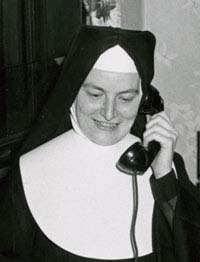
Mary Madonna Ashton, CSJ has an impressive Minnesota-based career in public and private service. She served as president and CEO of St. Mary’s Hospital in Minneapolis, State Commissioner of Health under Governor Perpich, and founded St. Mary’s Health Clinics.
Sister Mary Madonna earned a bachelor’s in sociology and psychology from St. Catherine University (then the College of St. Catherine) in 1944. She holds a Master of Hospital Administration from the University of Minnesota, and a Master of Science in Social Work from St. Louis University. She worked in medical social work and hospital administration, ultimately serving as president and CEO at St. Mary’s Hospital in Minneapolis from 1962–1982.
The following year she was contacted by then Minnesota Governor-Elect Rudy Perpich who asked her to serve as Commissioner of Health, despite tremendous opposition (she was not a physician, she was a woman and a nun!). Sister Mary Madonna served as the Minnesota Commissioner of Health from 1983–1991, successfully addressing smoking cessation and AIDS prevention. She helped pass landmark legislation outlawing smoking in public places and on public property. Testifying for days against the tobacco industry, her success on behalf of the state of Minnesota started a nationwide movement.
Sister Mary Madonna was a trustee of St. Mary’s Junior College from 1974 to 1986 and at St. Catherine from 1986 to 1995 — shepherding both institutions through the merger that would, in 2007, become the Henrietta Schmoll School of Health.
After leaving state government in 1991, Sister Mary Madonna joined other Sisters of St. Joseph in creating what would become St. Mary’s Health Clinics (SMHC) in 1992. Through the ministry, she spearheaded an innovative and compassionate effort to extend healthcare to uninsured citizens. By the time Sister Mary Madonna retired in 2000, SMHC had 11 clinics throughout the Twin Cities, which continue to serve families and individuals who have nowhere else to turn for medical care.
Daisy Bates
(1912-1999)
Civil Rights Organizer,
Leader of the Little Rock School Integration
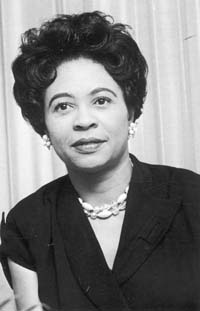
Daisy Gatson Bates was a journalist and Civil Rights activist who famously facilitated the 1957 integration of public schools in Little Rock, Arkansas. Growing up in southern Arkansas during the early 20th century, Bates experienced first hand the poor conditions and discrimination of the segregated school system. She spent her entire adult life standing up to physical threats and other forms of intimidation in order to champion causes of racial equality.
In 1941, Daisy Gatson married L.C. Bates, and moved with him to Little Rock where she helped him run a weekly newspaper called The Arkansas State Press. The newspaper focused on social and economic issues that particularly affected the black residents of the state, and often reported incidents of police brutality. Because the Bates’ refused to censor the details of these brutalities, many white businesses boycotted advertising in their newspaper.
In 1952, Bates was elected President of the Arkansas Branch of the NAACP. In that role she led the protest against the Little Rock School Board’s plan for gradual integration. In 1957, after the school board announced plans to commence desegregation at Central High School, Bates worked with the chosen nine African American students, guiding and advising them as they made their attempts to enter the school. On September 25, President Dwight Eisenhower sent
1,000 U.S. Army paratroopers to enforce the integration of the school, and Bates and the students were escorted and finally able, after many failed attempts, to safely enter the school.
In 1962, Bates published her autobiography, “The Long Shadow of Little Rock.” The following year she was the only woman selected to speak at the 1963 March on Washington. She went on to work for the Democratic National Committee’s voter education drive and for President Lyndon Johnson’s anti-poverty programs. When Daisy Gatson Bates died in 1999, more than 2,000 guests attended her memorial service in Little Rock, AR
Sonia Pressman Fuentes
(1928 – Present)
NOW co-founder, first woman attorney
in the Office of the General Counsel at the EEOC
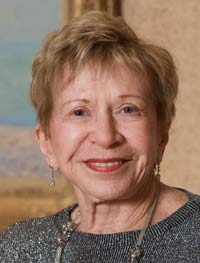
Sonia Pressman Fuentes is a lawyer, author, speaker and pioneering feminist leader who fought for women’s equality in the work force and helped initiate the Second Wave of the women’s rights movement.
Fuentes was born in 1928 in Berlin, Germany. When she was five years old, she immigrated to the US with her parents and brother to escape the Holocaust, arriving in New York City in 1934. In 1957 Fuentes graduated first in her class at the University of Miami School of Law.
She was the first woman attorney to work in the Office of the General Counsel at the Equal Employment Opportunity Commission (EEOC), a government agency dedicated to enforcing federal employment discrimination laws. While there, she became the staff person who stood for the aggressive enforcement of the gender discrimination prohibitions of Title VII of the Civil Rights Act of 1964. As the person who drafted a number of the initial landmark guidelines and decisions, Fuentes played an extremely significant role in increasing the opportunities for women in the work force in the second half of the 20th century.
Fuentes was one of the founders of the National Organization for Women (NOW) and was a charter member of the advocacy group Federally Employed Women (FEW). Fuentes has also served on the advisory committees of the Veteran Feminists of America (VFA) and the Longboat Key Education Center.
In 1999 she published a memoir, Eat First – You Don’t Know What They’ll Give You: The Adventures of an Immigrant Family and Their Feminist Daughter. Fuentes has dedicated her whole life to making equal rights for women in the work force, as well as in other arenas of society, a reality rather than just a promise. A key pioneer during the Second Wave of the women’s rights movement, the enduring impact of her work is still evident today. For further information on Fuentes, visit her website at http://www.erraticimpact.com/fuentes.
Isabel Gonzalez
(1882-1971)
Champion of Puerto Ricans
securing American Citizenship
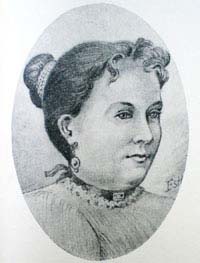
Isabel González was a Puerto Rican woman who fought for 15 years to ensure full U.S. citizenship rights for all Puerto Ricans. The United States acquired Puerto Rico from Spain in 1898 promising dignity to its people.
Isabel González left Puerto Rico in 1902, with plans to meet family and wed the father of her yet-to-be-born child in New York. While she was enroute, the U.S. tightened immigration restrictions on Puerto Ricans and upon arrival her ship was sent to Ellis Island, where she and many others were labeled aliens. González was additionally targeted as a feared “ward of the state” because of her pregnancy. Her family vouched for her at multiple hearings, confirming they had the financial means to support her and her child and that she would not become a government burden, but the authorities refused to release her from detention.
Her uncle, drawing on political connections, acquired a lawyer and seven weeks later Gonzales’ case was heard before the Circuit Court for the Southern District of New York. The court ruled against González, affirming her status as an alien. The case of González v Williams was heard before the U.S. Supreme Court in 1903; the court ruled only partially in González’ favor, finding that Puerto Ricans should not be treated as aliens, but still not granting them full citizenship. Her case was the first time the Supreme Court considered the matter of residents of U.S. territories having full U.S. citizenship.
Isabel González secretly married in 1903, gaining citizenship through her marriage. Still she continued her campaign for all Puerto Ricans to gain U.S. citizenship by writing countless letters to the New York Times. The issue was finally resolved in 1917 when Congress passed, and President Woodrow Wilson signed, the Jones-Shafroth Act, granting all Puerto Ricans American citizenship.
.
Ella Grasso
(1919-1981)
Governor of Connecticut, First Woman Governor
of any US State Elected in Her Own Right
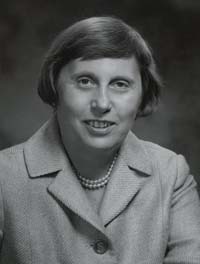
Ella Grasso was the first woman elected governor of a U.S. state in her own right, serving as Governor of Connecticut from 1974 through 1980. Grasso’s political career spanned over 45 years and she won all ten elections she ever ran in. The daughter of Italian immigrants, Ella Tambussi gained a commitment to public service at her alma mater Mount Holyoke College.
After serving as a speechwriter for the Connecticut Democratic Party during the 1940s, Grasso first ran for elected office in 1952 and won a seat in the Connecticut General Assembly. Serving in the CT Assembly until 1959, she became the first woman elected Floor Leader in 1955.
Elected CT Secretary of State in 1958, she was reelected twice and served in this role until in 1970 Grasso won election as a US Representative and served 2 terms in the United State House of Representatives. Grasso then won election as CT Governor in 1974 and was reelected to a second term. Grasso resigned in 1980 after being diagnosed with terminal ovarian cancer.
As governor Grasso had to make many challenging and unpopular decisions, but her commitment to creating a more effective government, balancing the budget, and adhering to the democratic process proved fruitful and she won the admiration and trust of her constituents. She led CT through tough economic times, making controversial cuts but also attracting new industries and companies to the state, and the state economy steadily improved under her leadership.
Ella Grasso is remembered as a trailblazing woman and a champion of marginalized groups including minorities, women, young people, the elderly, and the working class. Many believed Grasso would go on to serve in a national leadership role such as Vice President or cabinet member. Sadly, Grasso’s career and lifelong commitment to public service were cut short by her illness.
Suzan Shown Harjo
(1945 – Present)
Native American Public Policy Advocate and Journalist
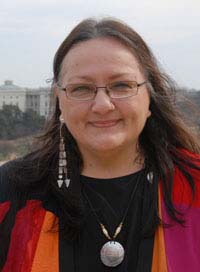
Suzan Shown Harjo is a Native American activist whose 50-year career includes work in journalism, poetry, curating, and policy advocacy. Descended from Cheyenne and Hodulgee Muscogee Nations, her accomplishments include helping Native peoples regain more than one million acres of tribal lands.
Harjo’s activism dates back to the mid 1960s when she co-produced the nation’s first Native American news radio show. It was also around this time that Harjo began her work with museums, first working with the Museum of the American Indian in New York, where she helped return sacred garments to their tribes and helped the museum change its policies to more respectfully present Native artifacts. Harjo has continued working with museums throughout her career, including working with the Smithsonian National Museum of the American Indian, which opened in 2004.
In the 1970s Harjo and her husband moved to Washington, D.C. where, after a few years working as a legislative assistant, she was appointed Congressional liaison for Indian Affairs by President Jimmy Carter. Her tireless lobbying efforts led to the 1978 passage of the American Indian Religious Freedom Act.
From 1984-1989, Harjo served as Executive Director of the National Congress of American Indians, where she continued to fight for the return of Native lands. She also successfully secured increases in appropriations toward Native American education programs.
Throughout her career, Harjo has spoken out against negative and stereotypical portrayals of Native Americans in movies and on television. A leader in efforts to remove negative Native names and images from sports teams; by 2013 her public campaigns had succeeded in more than two-thirds of teams moving away from Indian mascots. In 1984, Harjo founded the Morning Star Institute in memory of her late husband. Still serving as the organization’s president today, Harjo continues to promote sacred land claims and traditional cultural rights. In 2014, Suzan Shown Harjo received the Presidential Medal of Freedom from President Barack Obama.
Judy Hart
(1941- Present)
National Park Founding Superintendent of
Rosie the Riveter World War II Home Front National Historical Park
and Women’s Rights National Historical Park
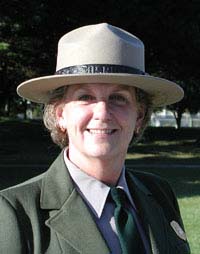
Judy Hart is a civic activist and consultant whose 27-year career with the U.S. National Park Service (NPS) and other seminal work has helped legitimize and raise awareness of women’s history in America.
After receiving a graduate degree in Law from Goddard College, Hart began her career in publishing. After working as an editor at Little, Brown and Company, Hart went on to work for the Federal Highway Administration on Environmental Impact Statement reviews, later becoming the Director of the Bureau of Relocation for Massachusetts. Hart began her career with the NPS in 1976, working both in Washington, D.C. and the Boston area. She helped establish the Marsh Billings National Historical Park, the Mary McLeod Bethune National Historic Site, the Petroglyphs National Monument, along with other park units.
During her tenure at NPS Hart also became the first National Program Coordinator for the National Heritage Area. Judy Hart moved to Seneca Falls, NY, and after initially suggesting the idea, worked on the study and legislation to establish the Women’s Rights National Historical Park, becoming the first superintendent upon its inception in 1980.
Before retiring in 2005, Hart became the first superintendent of the Rosie the Riveter/World War II Home Front National Park in Richmond, CA, and was instrumental in making the park a reality. Prior to becoming Superintendent, Hart coordinated the study for the new park, which
is dedicated to recognizing the vital contributions that women made on the home front during World War II.
Over 9,000 Rosies have contributed their stories to the park, and more than 2,000 have donated their personal items and mementos for safekeeping of the Park. Through Judy Hart’s tireless efforts, the stories and experiences of countless women across the country now have a place to be physically recognized and honored by the public through our National Park system.
Oveta Culp Hobby
(1905-1995)
WWII Director of the Women’s Army Auxiliary Corps and
first Secretary of the US Department of Health, Education, and Welfare
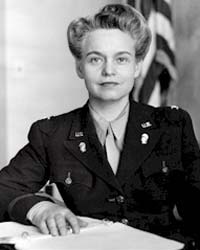
Oveta Culp Hobby was a pioneer military leader who helped define women’s initial role in the Army during World War II. She served as the first commanding officer of the Women’s Army Corps (WAC), was the first secretary of the Department of Health, Education and Welfare, and was the Chairperson of the Board of the Houston Post.
After receiving her law degree from the University of Texas in 1925, she worked as a parliamentarian for the Texas House of Representatives and, in 1930, was appointed the assistant to the city attorney of Houston. A year later she married William P. Hobby, a former Governor of Texas and then publisher of the Houston Post. Hobby helped her husband run the Post for ten years before moving to Washington, D.C. to work as the head of the War Department’s Women’s Interest Section.
In 1942 Hobby became the first Director of the newly formed Women’s Army Auxiliary Corps, later the Women’s Army Corps, under which over 150,000 women served. For the first year all WACs were volunteers, and Hobby often had to fight to get resources and recognition for the Corps. Challenging all gender norms, the Corps faced opposition from both the public and male service members, but as they freed up more men for combat the women quickly proved their worthiness. At the end of Colonel Hobby’s tenure WACs filled 239 different army positions, more than four times initial estimates.
Colonel Hobby was awarded the Distinguished Service Medal in 1945. After the war she was appointed the first secretary of the Department of Health, Education, and Welfare, a position that she held until 1955. She returned to publishing and broadcasting, with several later positions, including working as the president and editor of the Houston Post, and as the director of the Corporation for Public Broadcasting. Oveta Culp Hobby passed away in 1995 in Houston, Texas.
Barbara Mikulski
(1936 – Present)
Longest Serving Woman in the United States Congress
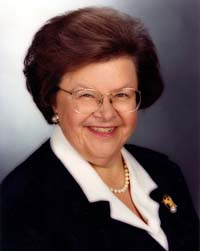
Barbara Mikulski is the Senior Senator from Maryland representing the Democratic Party. Starting her career as a social worker, In Congress Mikulski has championed such efforts as equal pay, a woman’s right to choose, improving health care for and medical research on women, and subsidizing child-care for low-income families.
Mikulski earned a master’s of social work degree from the University of Maryland in 1965 and returned to her hometown of Baltimore to work with at–risk children and educate seniors about Medicare. Her work soon evolved into community activism when she successfully organized communities against a plan to build a 16–lane highway through the heart of Baltimore.
Mikulski used her community activism momentum to win her first election to the Baltimore City Council in 1971. After serving Baltimore for five years, Mikulski won her first Congressional campaign in 1976, representing Maryland’s 3rd district for the next 10 years. Responding to the growing popularity of Women’s History Week, in 1981, Sen. Orrin Hatch (R-Utah) and Rep. Barbara Mikulski (D-Maryland) co-sponsored the first Joint Congressional Resolution proclaiming a Women’s History Week. Congress passed their resolution as Pub. L. 97-28, which authorized and requested the President to proclaim the week beginning March 7, 1982 as “Women’s History Week.”
In 1986, Mikulski ran for Senate and won, becoming the first Democratic woman Senator elected in her own right. She was re–elected with large majorities in 1992, 1998, 2004 and 2010.A leader in the Senate, Mikulski is the Dean of the Women – serving as a mentor to other women Senators and working to form bipartisan coalitions. On January 5, 2011, Mikulski became the longest serving woman Senator in U.S. history and on March 17, 2012 she became the longest–serving woman in the history of the United States Congress. Of these milestones, she says, “It’s not about how long I serve, but about how well I serve my state and my nation.”
In November 2015, Mikulski received the Presidential Medal of Freedom from President Obama. Senator Barbara Mikulski will retire after finishing her fifth Senate term in December 2016.
Inez Milholland
(1886-1916)
Woman Suffrage Leader and Martyr
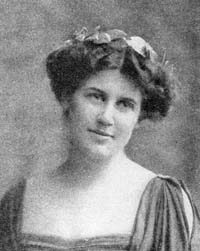
Woman suffrage leader and martyr Inez Milholland Boissevain gave her life working for the Woman Suffrage movement. Because of what she and other suffragists did, women won the basic right to vote. Milholland was a lawyer who also fought for the rights of working class women, spoke out for racial equality, and worked for prison reform.
Milholland became active in the suffrage movement as a student at Vassar where her suffrage meetings were eventually banned from campus. For six years, she was involved in the drive for Votes for Women in New York, memorably lobbying state lawmakers and leading annual suffrage parades up Fifth Avenue. In 1913, she helped plan the Woman Suffrage Parade in Washington, D.C., and she famously led the parade wearing a cape and crown atop a white horse.
In 1916, she accepted the role of “Flying Envoy” on a speaking tour of the western states. Across the West she addressed women who were new voters with passion and conviction; “Now, for the first time in our history, women have the power to enforce their demands, and the weapon with which to fight for woman’s liberation.”
In October 1916, after dramatically asking, “Mr. President, how long must women wait for liberty,” she collapsed before a large audience in Los Angeles, CA. She died a month later of pernicious anemia. Fellow suffragists recognized that her love of democracy and devotion to women made her a martyr for the cause. On Christmas Day, an unprecedented memorial was held for her in the U.S. Capitol’s Statuary Hall, the first woman to be honored there. A week later, suffragists carried her final plea on their banners when they began to picketed the White House.
Over her brief life, Inez Milholland Boissevain personified the goal of Votes for Women, and today she symbolizes the perseverance and sacrifices required to win equality for women.
Be sure to check out the documentary about her life and work in Inez Milholland ~ Forward Into Light
Karen Narasaki
(1958–Present )
Civil and Human Rights Leader
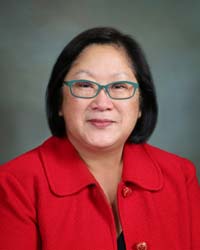
Karen Narasaki is a Civil Rights lawyer, lobbyist, and leader who has dedicated her career to issues of Asian American equality. Her work has focused on voting rights, affirmative action, family immigration, media representation, and hate crimes prevention. Narasaki served as a Commissioner on the U.S. Commission on Civil Rights.
Narasaki served as Washington, D.C., representative for the Japanese American Civil Rights League (1986–1994) and as President and Executive Director of the Asian American Justice League (1995–2012). Her leadership led to passage of stronger hate crimes and voting rights laws and helped defeat legislation that would erode the family immigration system. She also helped ensure a more accurate counting of Asian American and Pacific Islanders in the U.S. Census and ensured that these populations maintained access to affirmative action programs. In addition to her work on legal issues, Narasaki is former chair of the Asian Pacific American Media Coalition. Her efforts to improve AAPI representation in the media led to 20% increases in regular and recurring AAPI characters on network television.
In 2014, President Barack Obama appointed Narasaki to serve as a Commissioner on the U.S. Commission on Civil Rights. This eight-member bi-partisan commission serves as a government watchdog, investigating, reporting on, and making recommendations concerning civil rights issues facing the nation. Previously, she advised President Bill Clinton on civil rights issues and in 2009, she was appointed to the Advisory Committee on Diversity for Communications in the Digital Age of the Federal Communications Commission.
Narasaki’s efforts on multiple occasions (such as her work on voting rights) have worked to strengthen ties with African American, Latino, Native American, and other minority communities.
Narasaki has received numerous awards and honors including the National Asian Pacific American Bar Association Trailblazer Award (1994), the U.S. Department of Justice Citizen Volunteer Service Award (2000), and the Congressional Black Caucus Chair’s Award (2005). Washingtonian Magazine named Karen Narasaki one of “the 100 most powerful women in Washington, D.C.” four separate times.
Nancy Grace Roman
(1925 – Present)
Chief of Astronomy at NASA
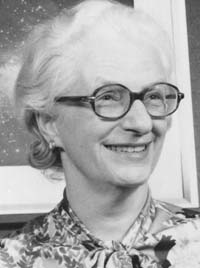
Nancy Grace Roman is an astronomer and was the first women executive at the National Aeronautics and Space Administration (NASA). Roman is known as the “Mother of Hubble” for her contributions to establishing the Hubble Space Telescope. Throughout her career Roman has been an outspoken advocate for women in the sciences.
Roman showed interest and talent in the sciences from an early age, but like many women of her time she was discouraged by teachers at all levels who thought women were not suited to study science. Roman persevered; receiving a Bachelor’s degree in astronomy from Swarthmore College in 1946, and completing a PhD in astronomy at the University of Chicago in 1949. Roman stayed at the University for six years working as a researcher and instructor, but left due to the limited opportunities for women.
Roman worked at the Naval Research Laboratory before being hired by newly formed NASA in1959 to create the organization’s space astronomy program. Roman worked at NASA for 21 years followed by working as a consultant for companies contracted with NASA. She fully retired in 1997, and began extensive volunteer work including conducting science programs in underserved Washington, D.C. schools.
Nancy Grace Roman’s career was groundbreaking not only as a woman scientist, but also in her research discoveries and the programs she created. She discovered the first clues to the evolution of the Milky Way galaxy, mapped the sky at 67 centimeters, and helped improve the accuracy of measurements to the distance of the moon. At NASA Roman led a program that launched over 20 satellites and 3 orbiting solar observatories. Roman laid the early groundwork for the Hubble Space Telescope, setting the program’s structure, recruiting astronomers, and lobbying Congress to fund it. Roman’s many awards and honors include The Federal Woman’s Award (1962), NASA’s Exceptional Scientific Achievement Award (1969), and a NASA fellowship in astrophysics is named in her honor.
Bernice Sandler
(1928 – Present)
Women’s Rights Activist, “Godmother of Title IX”

Bernice (Bunny) Sandler is a women’s rights activist, best known for her groundbreaking work fighting sexual harassment and discrimination on college campuses. Labeled the “Godmother of Title IX,” Sandler both led efforts for the legislation’s enactment and became a national expert on the law’s implementation.
Despite holding a doctorate degree, Sandler was unable to obtain a full-time faculty position because of the institutional sexism facing women in academia. In the1960s.women held more terminal degrees than ever before, yet female professors were routinely denied faculty jobs and tenure. Although Title VII of the Civil Rights Act of 1964 prohibited discrimination in employment based on sex, it excluded educational institutions. Determined to legally fight collegiate sexism, Dr. Sandler used an obscure Executive Order, issued in 1968 by President Lyndon Johnson prohibiting sex discrimination by federal contractors, to file the first federal sex discrimination lawsuits against every college with federal contracts, about 250 in all.
Dr. Sandler’s lawsuit got the attention of Congresswoman Edith Green (D-Oregon), who assembled the first Congressional hearings on sex discrimination in education and employed Sandler as an expert. From there the idea for a law banning sex discrimination in federally-funded education programs was born. Cosponsored by Congresswoman Patsy Mink (D-Hawaii), Title IX passed two years later and was signed into law by President Richard Nixon in 1972.
Title IX immediately ended overt sex discrimination in educational admissions and hiring practices. But in 1974, Sandler and others realized that the law could also cover discrimination in scholastic athletics, ending a system in which women’s programs were rarely funded or even offered. The law has more recently been used to better address sexual violence on campus.
Through her long career Bunny Sandler has written three books and more than 100 articles, given more than 2,500 presentations, and served as a media expert on sex discrimination in education.
Nadine Smith
(1965 – Present)
LGBT Civil Rights Activist
and Executive Director of Equality Florida
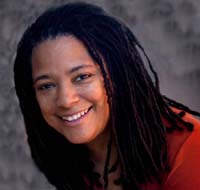
Nadine Smith is a national leader in LGBT rights activism. She is executive Director of Equality Florida and was executive director of its predecessor organization, the Human Rights Task Force. As a lobbyist, activist, and leader Smith works tirelessly to improve the lives of Lesbian, Gay, bisexual, and Transgender Americans.
Smith began her activism in college, and in 1986 she served on the founding board of the International Gay and Lesbian Youth Organization. She served as one of four national co-chairs on the 1993 March on Washington, coordinating national and international media coverage, and took part in the historic, first-ever meeting between LGBT leaders and a sitting U.S. president, President Bill Clinton, in the White House. Smith served four terms as co-chair of the Equality Federation and served as a member of the Democratic National Committee. Executive Director of Equality Florida since the organization’s inception in 1997, Smith has led advocacy efforts in Florida at the state level at a time of unprecedented attacks on the LGBT community. She led efforts to stop discriminatory legislation and ballot measures and to overturn Florida’s ban on adoption by gay and lesbian parents. Smith is an outspoken advocate for hate crimes and bullying legislation. In 2008, Equality Florida’s efforts led to passage of a state anti-bullying law that spurred school districts across Florida to add sexual orientation and gender identity to their bullying policies.
Smith has been recognized for her national and state leadership by organizations including the National Gay and Lesbian Task Force, the Human Rights Campaign, the National Center for Lesbian Rights, and the National Black Lesbian and Gay Leadership Forum. A former award-winning journalist, she has written syndicated columns for various LGBT and general audience publications.
In 2013, Nadine Smith was named by the Florida Diversity Council as one of the “Most Powerful and Influential Women” in Florida.
Dorothy C Stratton
(1899-2006)
WWII Director of the SPARS (Coast Guard Women’s Reserve),
First full-time Dean of Women at Purdue University, and Executive Director of the Girl Scouts of the USA
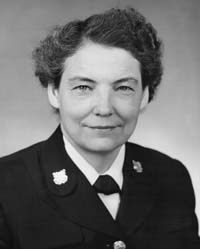
Dorothy C. Stratton was a trailblazer throughout her career, but is perhaps best known for being Director of SPARS, the United States Coast Guard Women’s Reserve during World War II. Prior to joining the military, Stratton was Purdue University’s first full-time Dean of Women (1933 -1942). She greatly expanded the female curriculum beyond Home Economics and female enrollment at Purdue nearly tripled. She was still Dean of Women until she took a leave of Absence in 1942 for WWII.
Stratton was the first woman to be accepted for service in U.S. Navy after President Franklin Roosevelt signed the amendment creating a women’s reserve program. After completing her initial training, she was assigned as the Assistant to the Commanding Officer of the Radio School for enlisted WAVES Women Accepted for Voluntary Emergency Service) at Madison, WI. On November 14, 1942, she transferred to the U.S. Coast Guard and became the director of the Women’s Reserve.
Her major and lasting contribution to the Coast Guard was the development of the SPAR program, which allowed women to join the Coast Guard for the first time in history. Enlistment in the program grew rapidly in a short span of time; during the remaining years of the war more than 10,000 enlisted, and 1,000 officers served their country through this program. By 1944, one out of every 15 persons enlisted in the Coast Guard was a woman.
After the war, Stratton became the first Director of Personnel at the International Monetary Fund, serving in that capacity until 1950. She then went on to become the National Executive Director of the Girl Scouts of America, remaining in that position for ten years before retiring in 1960. In 2001, the Coast Guard Women’s Leadership Association named the “Captain Dorothy Stratton Leadership Award” in her honor. Dorothy Stratton died in 2006, at the age of 107.
In 2012, First Lady Michelle Obama commissioned a coast guard cutter in honor of Dorothy Stratton. It was the first time in history that a Legend-class National Security Cutter was named after a woman, and the first time that a first lady sponsored a coast guard or navy ship.Today, the Cutter Stratton protects America’s shoreline.
Watch the book trailer here: https://www.youtube.com/watch?
Dorothy Stratton and the Spars, The Legend Continueshttps://vimeo.com/18510562
Betty Mae ‘Pa-Tuth-Kee’ Tiger Jumper
(1922-2011)
First woman elected Chairperson of the Seminole Tribe
becoming the first female Tribal Chief in North America
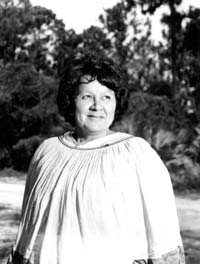
Betty Mae Tiger Jumper was a Seminole woman who worked her entire life to better the livelihood and commemorate the traditions of her tribe. During her long career she became the first woman to be elected Chief of a federally recognized tribe, integrated modern medicine into the community, and insured the endurance of the traditions and oral history of the Seminole Tribe through the publication of two books and the creation of the Seminole Indian News.
As a young girl, Betty Mae Tiger was eager to be educated. Speaking only Creek and Miccosukee at age 14, she entered the Indian boarding school in Cherokee, NC, and was the first Florida Seminole to learn to read and write English and graduate from high school. She trained as a nurse and upon returning home she traveled between various reservations, bringing her knowledge of modern medicine with her.
In 1967, after working as Vice Chair and with the encouragement of fellow tribal women, Tiger Jumper ran against three male opponents for the seat of Seminole Tribe of Florida Chairman and won, becoming the first elected female tribal chief in the U.S.
During her tenure (1967- 1971) she created the initial United Southeastern Tribes (USET) coalition, which today consists of more than 26 tribes and works at the regional and federal level on health and educational efforts. Additionally, Tiger Jumper managed to financially rescue the nearly bankrupt tribe through a variety of efforts, including leasing Seminole lands to US highways and citrus growers.
In addition to her political work, Betty Mae encouraged Seminole oral history preservation, and particularly stressed the importance of young people learning and honoring their history. She founded the first Seminole newspaper, the Seminole Indian News, and used it as a way to publish and distribute Seminole stories. Betty Mae Tiger Jumper’s work not only improved the well-being of thousands, but also helped ensure the legacy of her tribe.
